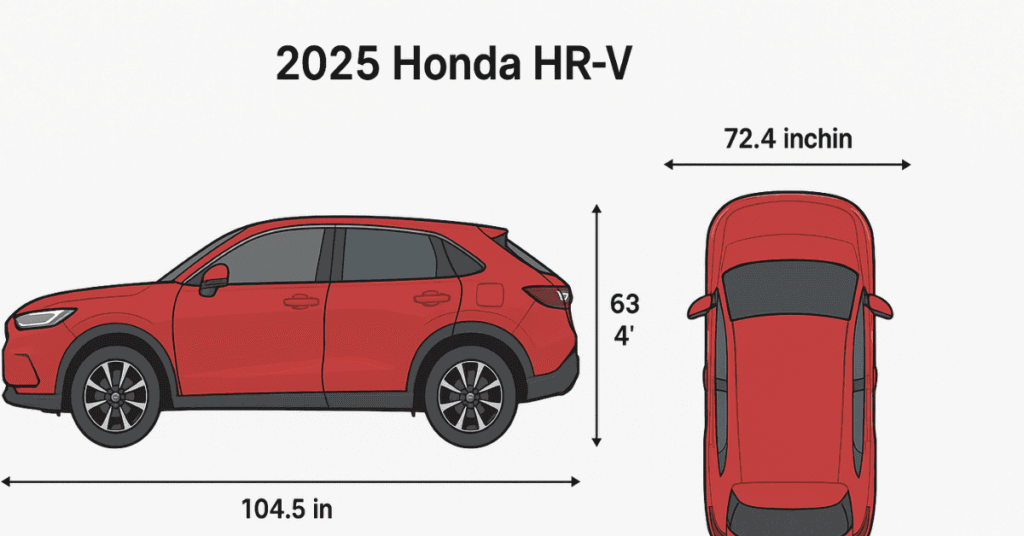2025 Honda HR-V Dimensions: What You Need to Know

If you’re in the market for a compact SUV, one of the first questions is: will it fit your daily needs in terms of size, garage clearance, and interior space? The 2025 Honda HR-V dimensions are key to understanding just how practical this B-segment crossover really is.
In this post, we’ll break down its exterior footprint, interior room (legroom, headroom, shoulder room), cargo capacity, and utility. We’ll also compare it to rivals to see whether the HR-V delivers strong packaging in its class.
Overview: Why Dimensions Matter for a Compact Crossover
The size of a small crossover such as the HR-V is a compromise. On the one hand, you desire a small footprint to drive on the urban roads, parking, and manoeuvre. On the other, there is desired sufficient cargo capacity, passenger comfort and useful interior space. The HR-V of the 2025 is designed to achieve this balance with Honda being the modern architecture.
The size influences not only the turning radius (in small city environments) but also the roof height (overhead garage clearance) or the addition of a roof rack, the usability of the cargo (how much can be carried with or without folding down the rear seats). Each of the essential measurements is shown below in terms of what it entails in practice.
Exterior Dimensions & Footprint

Length, Width & Height
- The overall length of the 2025 HR-V is 179.8 inches (≈ 4,57 meters).
- Its width (without mirrors) measures 72.4 inches (≈ 1,84 meters).
- Height varies slightly by trim: 63.4 inches (~1,61 m) for many versions, while some trims carry 63.8 inches (~1,62 m).
These dimensions place the HR-V squarely in the compact crossover class: it’s longer and wider than many subcompacts but stays manageable in tight driving environments.
Wheelbase & Track
- The wheelbase (distance between front and rear axles) is 104.5 inches (≈ 2,66 m).
- Front track / rear track measure 62.6 inches / 63.2 inches (≈ 1,59 m / 1,60 m) respectively.
A longer wheelbase generally improves ride comfort and rear-seat legroom, while the track width influences stability and cornering grip.
Ground Clearance, Approach & Departure Angles
- Ground clearance (unladen) is 7.0 inches on many trims, but select trims get a slightly higher 7.3 inches (≈ 178–185 mm).
- Some approach/departure angle specs: 15.5° / 20.5° (lower trim) up to 16.0° / 21.1° (higher trim).
That clearance is respectable for occasional rough roads or speed bumps, though it’s not built for serious off-roading.
Curb Weight
- Depending on drive layout and trim, curb weight ranges from ~3,159 lbs (≈ 1,433 kg) to 3,336 lbs (≈ 1,513 kg).
- For example, a 2WD (front-wheel drive) model might be ~3,159 lbs; AWD and higher trims, heavier.
The lightweight nature aids fuel economy and agility.
Interior Space & Comfort

Passenger Volume & Seating Capacity
- Passenger volume for FWD/AWD versions: 98.7 cubic feet (~2,795 L)
- Seating remains for up to 5 occupants in a 2-row, 5-seat configuration.
Legroom, Headroom & Hip/Shoulder Room
- Front legroom: 41.9 inches (≈ 1,064 mm)
- Rear legroom: 37.7 inches (~958 mm)
- Front headroom: 39.4 inches
- Hip room (front / rear): 54.0 in / 47.4 in
In practice, the HR-V offers solid comfort for average-height adults. Taller occupants may find rear legroom a bit tight on long drives—but typical for this segment.
Rear Seat & Folding Capability

- The rear seats fold in a 60/40 split to allow flexible cargo/passenger combos.
- With seats upright, cargo volume is ~24.4 – 24.5 cubic feet (≈ 691–694 L)
- With rear seats folded, maximum cargo capacity increases to 55.1 cubic feet (≈ 1,560 L)
That makes it highly competitive in its class for load-carrying flexibility.
Utility & Maneuverability
Turning Radius / Curb-to-Curb Turning Diameter
- Turning diameter (curb-to-curb): 35.1 ft for many trims; some say 37.1 ft depending on wheel/tire setup.
This compact turn circle helps in parking lots and tight residential areas.
Door Opening & Load Floor Height
While Honda doesn’t publicly list “door opening width/height,” real-world tests show rear doors open wide enough to load bulky items and allow easier child-seat installation. The load floor is relatively low, which reduces lift-over height when loading cargo.
Roof Height with Accessories
With 63.8 inches roofline, adding roof rails or crossbars will add clearance. Taller roof-mounted cargo (kayaks, bikes) may require checking garage clearance.
2025 Honda HR-V Dimensions — Spec Table
| Spec Category | Measurement | Notes / Trim Variants |
| Length | 179.8 in | ≈ 4.57 m |
| Width (w/o mirrors) | 72.4 in | ≈ 1.84 m |
| Height | 63.4 – 63.8 in | Varies by trim |
| Wheelbase | 104.5 in | ≈ 2.66 m |
| Front / Rear Track | 62.6 / 63.2 in | ≈ 1,59 / 1,60 m |
| Ground Clearance | 7.0 in (some 7.3 in) | ≈ 178 mm (up to ~185 mm) |
| Cargo (rear seats up) | 24.4 – 24.5 cu ft | ≈ 691 – 694 L |
| Cargo (rear seats folded) | 55.1 cu ft | ≈ 1,560 L |
| Passenger Volume | 98.7 cu ft | ≈ 2,795 L |
| Front Legroom / Rear Legroom | 41.9 in / 37.7 in | ≈ 1,064 mm / 958 mm |
| Front Headroom | 39.4 in | ≈ 1,001 mm |
| Hip Room (front / rear) | 54.0 in / 47.4 in | ≈ 1,372 mm / 1,204 mm |
| Curb Weight | ~3,159 – 3,336 lbs | ≈ 1,433 – 1,513 kg |
| Turning Diameter | ~35.1 ft | Some trims up to ~37.1 ft |
How the HR-V Measures Up: Competitor Comparison
To see whether the HR-V delivers excellent packaging for its footprint, let’s compare it against a few competitors: Toyota Corolla Cross, Kia Seltos, and Mazda CX-30.
| Model | Length | Width | Cargo Volume (seats up / folded) | Front Legroom | Rear Legroom | Turning Diameter |
| 2025 HR-V | 179.8 in | 72.4 in | 24.5 / 55.1 cu ft | 41.9 in | 37.7 in | ~35.1 ft |
| Toyota Corolla Cross | ~175.8 in | ~71.9 in | ~25.5 / ~66.8 cu ft* | ~41.7 in | ~34.8 in | ~35.4 ft* |
| Kia Seltos | ~172.4 in | ~70.9 in | ~26.6 / ~62.8 cu ft* | ~41.4 in | ~38.0 in | ~35.8 ft* |
| Mazda CX-30 | ~173.0 in | ~70.7 in | ~20.2 / ~45.2 cu ft* | ~41.7 in | ~36.3 in | ~36.5 ft* |
From this snapshot:
- The HR-V is on the larger side (in length/width) within this segment, offering a more spacious cabin footprint.
- Its cargo volume when folded is among the highest here—55.1 cu ft is generous compared to many rivals.
- Rear legroom is competitive; some rivals sacrifice rear legroom for styling or other tradeoffs.
- Turning diameter is tightly comparable, showing Honda prioritized maneuverability.
Overall, the HR-V succeeds in delivering above-average usability for its class.
Real-World Implications & Use Cases
Will the HR-V Fit in a Standard Garage?
Yes. With a height of ~63.4–63.8 inches (~1.61–1.62 m), you have margin even in typical 7-foot (84 in / ~2.13 m) garage doors. If you add roof accessories (bike rack, roof box), measure the full height to avoid clearance issues.
Carrying Cargo and Tall Loads
The rear seats can be folded and offer almost a flat load area and length. The 55.1 cu ft capacity allows you to transport longer items (e.g. small furniture, skis). It is assisted by the low load floor where heavy boxes in and out are to be taken.
Fit for 5 Passengers?
On shorter to middle distance journeys, yes–the HR-V has 5 adult seats. The rear legroom can be a little tight in longer trips or when the rear seat passengers are very tall. A midsize crossover could be more appropriate to families that are more comfortable with the rear.
Off-road / Rough Terrain Use
Don’t expect off-road performance. The 7–7.3 in ground clearance is fine for rough city roads, steep driveways, and light gravel, but not for serious trails. Approach/departure angles are modest. The HR-V is built for urban and highway use, not rugged off-roading.
Strengths vs Weaknesses: Packaging Edition
Strengths:
- Excellent cargo utility: 55.1 cu ft with folded seats is among the segment’s leaders.
- Strong passenger volume for its footprint.
- Maneuverable turning circle and compact outer dimensions.
- Competitive interior space for front-seat occupants, making it comfy for driver and front passenger.
Weaknesses / Trade-offs:
- Rear-seat legroom is adequate but not generous for very tall passengers on long journeys.
- Ground clearance is modest—won’t please those needing more height.
- Roof-mounted cargo may push total height near clearance limits.
Tips & Things to Note (for Buyers / Owners)
- Check trim-specific dimensions — Slight height differences occur across trims (63.4 vs 63.8 in).
- Measure total height with roof accessories — Roof boxes, racks, or bike mounts add several inches.
- Inspect cargo opening size — While door-opening dims aren’t published, test how bulky items (boxes, luggage) fit in person.
- Compare actual interior comfort — Specs are useful, but test seating feel, seat cushions, and visibility in real life.
- Verify trim curb weight vs payload needs — Know the weight limits if you plan to carry heavy cargo or passengers.
For a deep dive into the 2025 HR-V specs and pricing, you can refer to Honda’s official site.
Conclusion
The 2025 Honda HR-V can be miniature, but every inch is worth it. Its design is intelligent and the space utilisation is high which has resulted in high levels of comfort, high level of practicality as well as easy manoeuvrability in a size that fits in the city. Whether it is the spacious interiors, or the sizeable cargo capacity, the HR-V demonstrates that small might be mighty, practical, and prepared to take everything your day by day will throw at you.
To explore official specifications, pricing, and available trims, visit Honda’s official 2025 HR-V specs page on Honda.com for verified manufacturer data.
Discover expert car tips, towing guides, and vehicle insights at CarFact.online.
FAQs About 2025 Honda HR-V Dimensions
Q: What are the dimensions of the 2025 Honda HR-V?
A: The 2025 Honda HR-V measures 179.8 inches long, 72.4 inches wide, and 63.4–63.8 inches tall.
Q: How much cargo space does the 2025 HR-V have?
A: Behind the rear seats, cargo capacity is ~24.4–24.5 cubic feet. When the rear seats are folded, the max expands to 55.1 cubic feet.
Q: What is the ground clearance of the 2025 HR-V in inches?
A: The unladen ground clearance is 7.0 inches, with certain trims getting 7.3 inches.
Q: What is the legroom front and rear in the 2025 HR-V?
A: Front legroom is 41.9 inches, and rear legroom is 37.7 inches.
Q: Does the 2025 Honda HR-V fit in a standard garage?
A: Yes — with a height of ~63.4–63.8 inches, the HR-V comfortably fits under a typical 7-foot (84 in) garage opening, leaving headroom for most roof accessories.
Have questions about the 2025 Honda HR-V Dimensions ? Contact us—we’re here to help you find the right answers.
